So Many Countries So Many Cultures
Unit Seven: Welcome to the English-speaking World
7.1. So Many Countries So Many Cultures
Word Bank | Phrase Bank | Communication Box |
Straight A’s Beforehand Abroad Score Rare Observe Excursion | To be a lifelong dream Not (to behave) like A bull in a China shop To feel at home Cultural do’s and Dont’s To have a mind trip To… To come true | Don’t you know? Now I see. I’d very much love to! Meanwhile,… You’d better (do). It’s not half enough. |
I. Conversation Warm-up
Look at the flags and say which of the English-speaking countries you would like to visit and why.
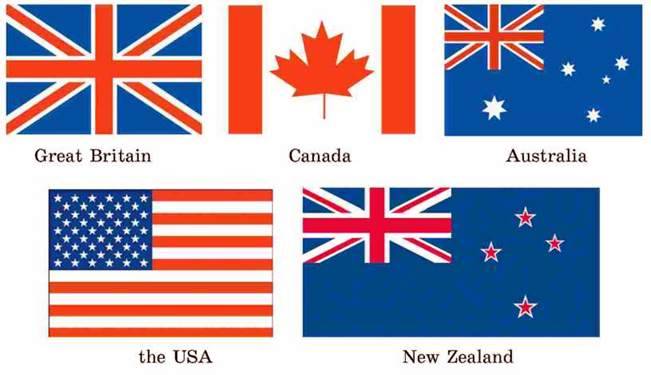
Example: I’d like to visit Great, Britain because I want to see Queen Elizabeth the Second.
II. Pronunciation Warm-up
Read and practise the sounds /еі/, /о/. Say in what countries you have international friends.
WE ARE ONE WORLD
Phil lives in England,
Martha lives in the USA,
But both like to go museums
And have huge sightseeing plans for May.
Barbara is from Poland,
Lucy is from Ukraine.
But both can create poems,
Do puzzles and play games.
Children live all over,
The world’s a giant ball.
But far and near, it’s very clear
We’re one world after all.
III. Grammar Smart
1. Look and recall.
Use Wh-questions – what, where, when, why if you want to get more information.
Example: Where does Lucy live?
A) Play a grammar chain game. Ask and answer questions about
Example: A: What is the capital of Great Britain?
B: It is London. What river is London situated on (located on)?
C: It is situated on (located on) the Thames.
Great
Canada
Australia
New Zealand
The USA
B) Look at the pictures and put questions to the answers given (p. 182).

Example:
– Where do Englishman buy fresh baked bread?
– At the corner shops, I think.
– … ?
– It is porridge.
– … ?
– Kangaroo lives in Australia.
– … ?
– Teenagers of the USA like to spend time in the mall.

– … ?
– Canadian boys enjoy playing hockey.
– … ?
– It’s McDonald’s.
– … ?
– It’s a favourite sport in Britain.
2. Read and Remember!

2) Use Neither do I/Neither am I/Neither can I/ when you want to say the same about yourself in reaction to your friend’s negative statement.
Example: 1. – I don’t have time to see everything in London.
– Neither do I.
2 . – I am not ready for a boat trip along the Thames yet.
– Neither am I.
3. – I can’t take pictures in the British Museum.
– Neither can I.
A) Let’s play a grammar tennis game.
A: I know someting about Great Britain.
B: So do I. But I don’t know much about New Zealand.
A: Neither do I
B) In pairs, match the statements to the responses.
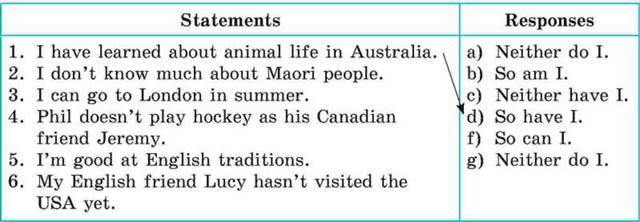
IV. Word Smart
1. In groups, read the fact files about some English-speaking countries and present them to the class.
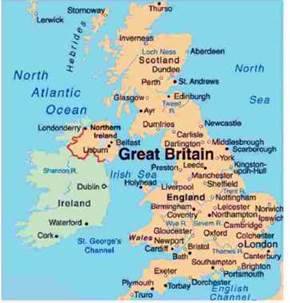
– Area: 229, 850 km2;
– Population: 62,300,000;
– 4 parts: England, Scotland, Wales, Northern Ireland;
– Queen Elizabeth II;
– Rivers: The Thames, the Severn;
– The highest mountain peaks: Snowdon, Ben Nevis;
– Capital: London.
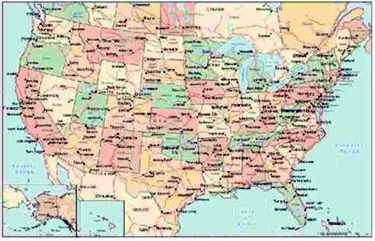
– Area: 9, 631, 419 km2;
– Population: 295,734,134;
– 50 states;
– Rivers and Lakes: the Mississippi, the Missouri, the Great Lakes;
– Mountains: the Rocky Mountains;
– Natives: Indians;
– Capital: Washington.
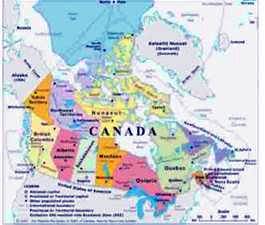
– Area: 9,984,679 km2;
– Population: 29,500,000;
– Queen Elizabeth II
– Natives: Innuits, Indians;
– Rivers and Lakes: the Niagara, Great Lakes, StLaurence river;
– Capital: Ottawa
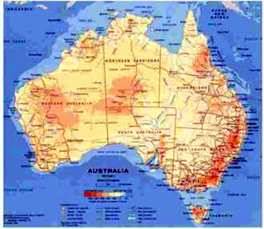
– A country and a continent;
– Area: 7,700,000 km2;
– Population: 20 mln;
– Queen Elizabeth II;
– Rivers: the Darling, the Murray;
– Natives: Aborigines
– Capital: Canberra.
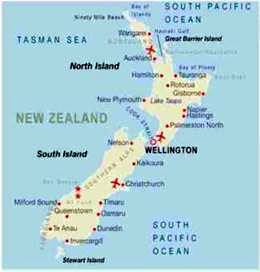
– 2 islands: North island, South island;
– Area: 268,000 km2;
– Population: 3,600,000;
– Queen Elizabeth II;
– Mountains: the Southern Alps;
– Natives: Maori people;
– Capital: Wellington.
2. Answer the questions:
1. What is your lifelong dream?
2. What must a traveller to English-speaking countries know not to behave like a bull in a china shop?
3. What cultural do’s and don’ts do you know?
4. What excursions do you like to have in an English-speaking country?
5. What must a traveller know to feel at home in any English-speaking country?
6. How must you plan a trip abroad?
At home: Write what countries you would like to visit and why.
Go to Ex. 101, 102 of your Workbook
V. Time to Listen and Read
1. Listen to / read in pairs. Say what information can help you to feel at home in the English-speaking countries.
TO KNOW A LANGUAGE IS TO KNOW ITS CULTURE
PART I
Steve: Gee! Look at my English test scores – they’re straight A’s.
Ann: What do you mean? I can see elevens and even a twelve in your paper.
Steve: Don’t you know? In America they use letter grades. A stands for an eleven or twelve and F means ‘fails’. So, as language learners, we can speak as American kids do.
Ann: I see. Congratulations. Now you can travel in the English-speaking world easily.
Steve: I’d very much love to. Touring London, Washington D. C., Ottawa, Canberra is my lifelong dream.
Ann: One day it will come true, I’m sure. Meanwhile, you shouldn’t waste time. You’d better get ready for the trip beforehand. To know a language is to know its culture, as our English teacher says.
PART II
Steve: I have already learnt a lot about great inventors and inventions, music and TV culture, places to visit and popular hobbies in some English-speaking countries.
Ann: Good of you, but it’s not half enough. There is much more to learn about the English-speaking world: writers and books, actors and films, singers and songs, art and artists.
Steve: I know, I know. There are also important cultural do’s and don’ts to understand, not to behave like a bull in a china shop abroad.
Ann: Exactly. What do you think of having a mind trip to the English-speaking world first?
Steve: That’s a good idea. It will help us to feel at home in an English speaking country when an opportunity presents itself. I have already learnt something about popular meals and school life in some English-speaking countries, the way they do the shopping and spend their weekends.
Ann: As I’m a great admirer of animals and rare plants, I’d like to go to Australia and look at the platypus and rat kangaroos.
Steve: It’ll be great!
Culture – cultural
History – historical
Education – educational
See First Aid Kit, Word-building, p. 214
Across Culture

Platypus – качкодзьоб, водоплавний ссавець, який мешкає в Австралії.
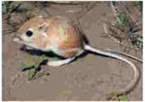
Rat Kangaroo – маленькі кенгуру.

Koala – маленький ведмідь, який живе на евкаліптових деревах, їсть до 1 кг листя і спить до 15 годин щоденно.
2. Fill in the right form of the word.
1. What are the cultural do’s of Great Britain?
2. I know little about this… area.
3. Testing is a big… problem.
4. Bristol is a big… city.
5. It is a well-known… event.
6. I adore this… programme.
Culture
Agriculture
Education
Industry
History
Music
3. Fill in the grid below with the information about Steve and Ann.
Steve | Ann |
Example: has grades “A” in English. | |
VI. Time to Communicate
1. Act as one of the children and speak about your lifelong dream. Use:
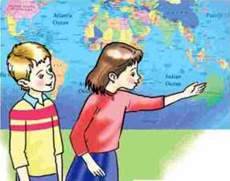
– to be a lifelong dream;
– cultural do’s and don’ts;
– to feel at home;
– not to behave like a bull in a china shop;
– to have a mind trip;
– to come true.
2. In pairs, talk about your mind trip to any English-speaking country as in the pattern.
Pattern:
A: Gee! Look at… .
B: What do you mean? I can see… .
A: Don’t you know? In… . So, as language learners, we can….
B: Now I see. Congratulations! Now you can… easily.
A: I’d very much love to. … is my life-time dream.
B: One day… , I’m sure. You’d better… .
A: I have already… .
B: Good of you, but it’s not half enough. There is much more to… .
A: I know, I know. It will help… .
VII. Time to Listen
1. Listen to Sarah’s story about spring in Australia and say if it comes at the same time as in Ukraine.
2. Listen to the story again and mark the true and false statements.
1. Many Australians spend Christmas on the beach.
2. Summer also starts in June in Australia.
3. Sarah enjoys spring, because she can be out of doors in any spring month.
4. Sarah feels as if in the country of Oz in the mountains.
5. Central desert is especially beautiful in autumn in Australia.
6. November is a spring month in Australia.
VIII. Time to Write
Plan a trip to any English-speaking country. Use the plan:
– country;
– place to see;
– cultural do’s and don’ts.
Go to Ex. 103, 104 of your Workbook